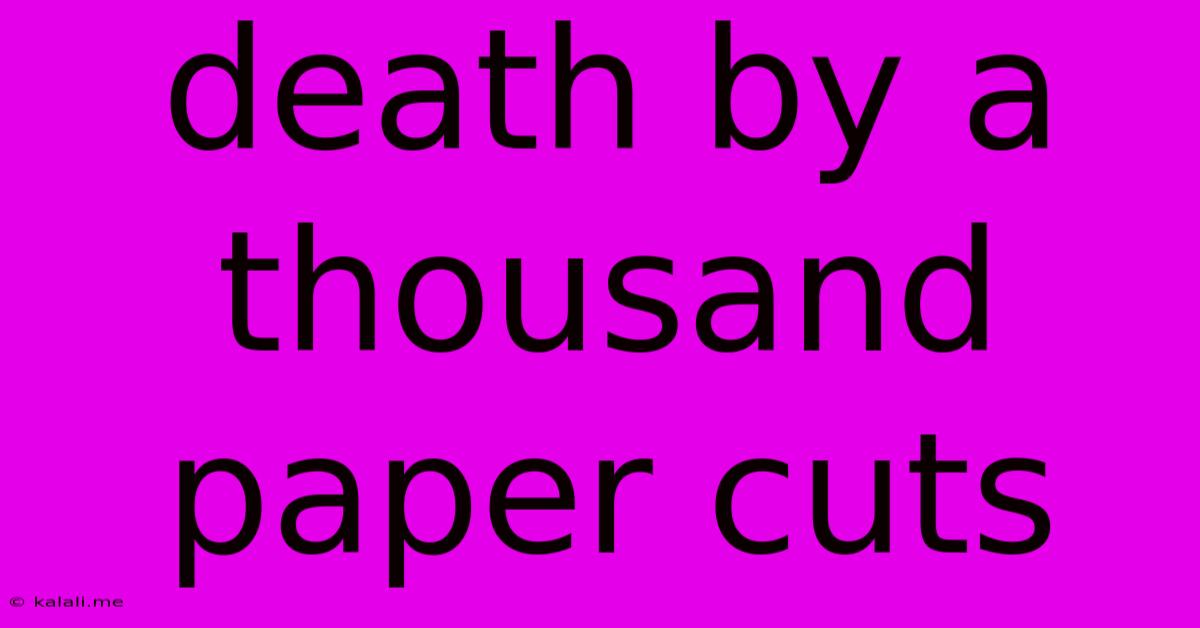Death By A Thousand Paper Cuts
Kalali
May 23, 2025 · 3 min read

Table of Contents
Death by a Thousand Paper Cuts: The Slow Kill of Micromanagement
Meta Description: Micromanagement, often unintentional, can be devastating to employee morale and productivity. This article explores the insidious effects of "death by a thousand paper cuts" and offers strategies for managers and employees alike to navigate this challenging workplace dynamic.
The phrase "death by a thousand paper cuts" perfectly encapsulates the insidious nature of micromanagement. It's not a single, catastrophic event, but a slow, relentless erosion of morale, productivity, and ultimately, employee well-being. This isn't about a tyrannical boss screaming orders; it's often more subtle, more insidious, and therefore, harder to identify and address. This article will explore the subtle yet damaging effects of micromanagement and offer solutions for both managers and employees caught in this debilitating cycle.
The Subtle Cuts: Recognizing the Signs of Micromanagement
Micromanagement manifests in many ways, often disguised as helpful guidance. However, these actions, when repeated, create a toxic work environment. Look out for these common signs:
- Constant Check-ins: Frequent, unnecessary updates and progress reports stifle autonomy and create a sense of distrust.
- Excessive Detailing: Managers dictating every minute detail of a task, leaving little room for creativity or independent problem-solving.
- Second-guessing: Constantly questioning decisions and choices, undermining the employee's confidence and judgment.
- Unnecessary Revisions: Demanding numerous revisions on tasks, even when the work is already completed to a high standard.
- Over-involvement in tasks: A manager taking on tasks that should be delegated to employees, leading to bottlenecks and delays.
- Lack of Trust: A general feeling that the manager doesn't trust the employee's ability to complete their work effectively.
- Ignoring employee input: Dismissing or overriding employee suggestions and ideas.
These seemingly small actions, repeated over time, accumulate into a significant burden, leading to burnout, resentment, and ultimately, a desire to leave the organization. The cumulative effect is far greater than the sum of its parts – the "thousand paper cuts" slowly bleeding the employee dry.
The Impact: More Than Just Frustration
The consequences of micromanagement extend far beyond simple frustration. It can significantly impact:
- Employee Morale: Constant criticism and lack of autonomy severely damage self-esteem and job satisfaction.
- Productivity: The constant interruptions and need for approval slow down workflow and decrease overall efficiency. Employees become less innovative and proactive, fearing negative feedback.
- Employee Turnover: High rates of employee turnover are often a direct result of a toxic work environment fueled by micromanagement. The cost of replacing skilled employees is substantial.
- Innovation and Creativity: A restrictive and controlling environment stifles creativity and the generation of new ideas, harming the organization's long-term growth.
- Team Dynamics: Micromanagement can create distrust and resentment among team members, hindering collaboration and teamwork.
Understanding these wider implications is crucial to addressing the issue effectively.
Healing the Wounds: Strategies for Managers and Employees
For Managers:
- Delegate Effectively: Trust your employees and empower them to take ownership of their work.
- Set Clear Expectations: Establish clear goals and deadlines, providing enough guidance without excessive control.
- Provide Constructive Feedback: Focus on providing positive reinforcement and specific, actionable suggestions for improvement.
- Foster Open Communication: Create a safe space for employees to voice concerns and seek clarification.
- Trust Your Team: Believe in your team's capabilities and allow them the space to grow and develop.
For Employees:
- Open Communication: Address the issue directly with your manager, expressing your concerns in a professional and constructive manner.
- Document Instances: Keep a record of instances of micromanagement, detailing the specific events and their impact.
- Seek Support: Talk to trusted colleagues, mentors, or HR representatives for guidance and support.
- Set Boundaries: Communicate your work preferences and boundaries clearly to your manager.
- Focus on Your Well-being: Prioritize your mental and physical health by practicing self-care and stress-management techniques.
Death by a thousand paper cuts is preventable. By understanding the subtle signs, acknowledging the impact, and implementing proactive strategies, both managers and employees can create a healthier, more productive work environment where everyone can thrive. Remember, a supportive and trusting work environment is not just beneficial for employees; it's crucial for the success of any organization.
Latest Posts
Latest Posts
-
Secure Email Luminos Is This Real
May 23, 2025
-
How To Scp From Remote To Local
May 23, 2025
-
How To Find Package Which Manager Terminal
May 23, 2025
-
Magento 2 Insert Newsletter Signup Form
May 23, 2025
-
Old 3 Way Switch To Motion Sensor
May 23, 2025
Related Post
Thank you for visiting our website which covers about Death By A Thousand Paper Cuts . We hope the information provided has been useful to you. Feel free to contact us if you have any questions or need further assistance. See you next time and don't miss to bookmark.